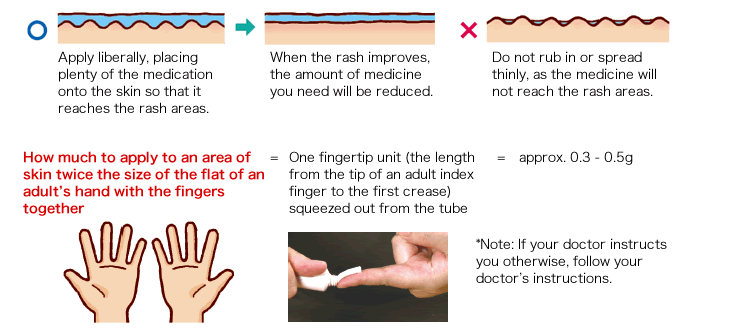Atopic dermatitis
Last updated on: 8 April 2019 | Released on: 21 April 2017
Important points to alleviate atopic dermatitis
- To reduce inflammation and restore the skin’s barrier function
“Keeping the skin clean” and “moisturizing your skin” as an integral routine
In atopic dermatitis, the skin is dry and its barrier function is compromised.
It is important to remove perspiration and other irritants from the skin by bathing and/or showering, and to keep the skin moisturized with plenty of emollient.
How to wash your skin to keep it clean
- Lather the soap well.
- Soap should be lathered thoroughly so that the foam is so fine and thick, it will not fall even when you hold your palm facing down.
- Wet your body in the bath or with the shower. This will loosen the impurities and make it easier to wash them away.
- Using your hands and generous amounts of the lathered soap, wash every part of your body.
- Wash inside elbows, knees, neck, and other joints. Gently spread out folds and creases to wash inside them.
- Also make sure you wash your face, around the eyes, and places where you have rash or red skin.
- After washing, rinse thoroughly with lukewarm water. Make sure there is no soap remaining on your skin.
- When drying your body, pat dry gently with a soft towel, blotting the moisture from your skin.
Tips for washing your body and face
The secret is to use plenty of fine-textured lather to wash your body.
However, impurities and irritants cannot be removed simply by letting the lather sit on your skin. Use your hands to spread the lather generously over every part of your skin.
Don’t miss any parts!
Elbows, knees, and other joints have folds and creases which tend to get missed, even when you think you’ve washed thoroughly.
Gently spread out the folds and creases to wash inside them.
Tips for applying topical medication and emollient
- Wash your hands thoroughly before applying.
- Apply as soon as possible after a shower or bath (within about 5 minutes of towel drying).
- Apply liberally, placing plenty of the medication or emollient onto the skin instead of spreading it thin or rubbing it in.
- Follow your doctor’s instructions as to where and how much medicine and emollient are to be applied, respectively.
- When lotion type medicine or emollient is to be used on the scalp, part the hair when applying to make sure it reaches the skin.
How much to use
- The skin should look and feel greasy/oily. There should be enough on the skin to hold a tissue paper in place without falling.
- One fingertip unit (the length from the tip of an adult index finger to the first crease) squeezed out from the tube is enough to treat an area of skin twice the size of the flat of an adult's hand with the fingers together.

(Illustration/photo taken from Environmental Restoration and Conservation Agency’s “Sukoyaka Life (Healthy Life)” Vol. 43)
Giving proper information to doctor for appropriate treatment
Factors which can worsen symptoms are different for each person.
It is important to notice which situations seem to trigger flare-ups, observe the degree of rashes and itchiness, and remember how you treated the condition and the results of the treatment. Make sure you convey this information to your doctor.
Tips for conveying information properly to your doctor
Conveying the proper information to your doctor helps to identify triggering factors and how itching worsens, which may help to deal with your condition.
- Jot down the points you want to convey and have them ready when you visit your doctor.
- Take photos of rashes when they occur.
- Another idea might be to keep a diary with a numerical point system to rate the degree of itchiness or the quality of your sleep.

